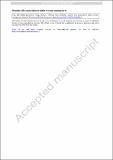Dynamic offer generation in airline revenue management
Author(s)
Wang, Kevin K.; Wittman, Michael D.; Bockelie, Adam
Download41272_2021_349_ReferencePDF.pdf (2.023Mb)
Publisher Policy
Publisher Policy
Article is made available in accordance with the publisher's policy and may be subject to US copyright law. Please refer to the publisher's site for terms of use.
Terms of use
Metadata
Show full item recordAbstract
Abstract
The New Distribution Capability and new retailing platforms will enable airlines to respond to shopping requests with bundled offers of flights and ancillary services, representing an evolution from traditional, flight-focused optimization. Assembling an attractive set of offers to display to customers therefore represents a new joint pricing and assortment optimization problem in airline revenue management. In this paper, we introduce an initial optimization approach for the selection and pricing of a la carte and bundled flight and ancillary offers. First, we propose a customer choice model that captures the impact of ancillary bundles on flight itinerary choice. We then calculate prices for each offer from a continuous range of price points and display the offer set that maximizes expected revenue for a given customer segment. We illustrate the approach using a single-flight, single-ancillary base case and discuss extensions to more complex environments. Tests in the Passenger Origin–Destination Simulator (PODS) show that dynamic offer generation (DOG) can increase net revenue when used by one or more airlines in a competitive network, assuming that the airlines are able to accurately segment incoming requests and estimate the average willingness-to-pay of each segment. We find that the majority of the revenue gains of DOG are due to competitive effects from the dynamic pricing of the flight component of the offer. The bundling mechanism of DOG is a secondary source of revenue gain that can be realized when customers take bundled ancillary services into account when choosing the flight. Our results provide insight for practitioners that are implementing offer optimization systems and processes. For example, in line with the previous literature on bundle pricing, we find that in transparent distribution channels an ancillary service should be bundled with the flight when the valuation for the ancillary is high or when its marginal cost of provision is low. We close by discussing the strategic and managerial implications of a move from traditional distribution strategies to a next-generation, offer-focused approach.
Date issued
2021-07-06Department
Massachusetts Institute of Technology. Department of Aeronautics and AstronauticsPublisher
Palgrave Macmillan UK
Citation
Wang, Kevin K., Wittman, Michael D. and Bockelie, Adam. 2021. "Dynamic offer generation in airline revenue management."
Version: Author's final manuscript